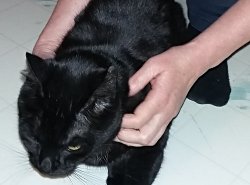The dangers of petting a cat

Cats are cute. They have those big eyes, round faces, small noses, and little pointy ears. The little pointy ears aside, cats have many of the features found in human infants. Human infants are designed by evolution to appeal to adults, because – as many an exasperated new parent can tell you – cuteness has to make up for many of baby's less endearing characteristics.
Yet cats were not designed by nature to appeal to humans, and their infantile features are merely a co-incidence. Those big eyes, pointy ears and little nose are in fact all part of the highly-evolved sensory apparatus of a basically anti-social predator. In a recent article in the website 'The Conversation' Lauren Finka, a postdoctoral research associate at Nottingham Trent University points out that being petted and cuddled comes naturally to an infant, but it does not come naturally to a cat.
In fact cats in the wild have evolved a system of scent markings which allow them to communicate with each other without actually having to meet in person, and many wild cats live essentially solitary lives without ever appearing to feel the need for company (apart from brief and rather violent mating sessions). Nor is the modern house cat far removed from its wild ancestors. Research has shown rather the opposite, in fact – modern cats are basically a wild species which has learned to tolerate being around humans as the price they pay for easily available food and comfortable living quarters.
Now this is not to say that cats can't bond with their humans. Some cats do, and very intensely too. But it does mean that this bond does not come naturally. For many humans their relationship with their cat actually may depend on what happened even before they met their future pet. If a kitten is handled and petted in the two to seven weeks after birth, some cats - some – learn to like being around humans and will seek their company out of preference. Other cats put up with humans being around, especially if they might soon pick up a tin opener.
Because of this, while many humans are stroking a cat and happily burbling baby talk to their little 'fur-baby', that fur baby may well be gritting its incisors and hoping that the human will get out of its face very soon. Sometimes kitty will suddenly snap, which is when a surprised and indignant human suddenly finds that the cat on their lap has metamorphosed from a cuddly ball of fur to a hissing, clawing demon.
So here, courtesy of Lauren Finka, is the guide to petting a cat.
Step one – let the cat initiate contact, or signal that it is ready for you to do so. If your cat leaps into your lap, or has its tail pointing up and waving gently it's in the mood for physical contact.
Step two – let the cat set the pace. If you stop stroking or petting the cat and you get a gentle bump or other signal to continue, all is well. A kneading action with the paws signals complete contentment, but purring is more ambivalent – a stressed cat might purr also.
Step three – give the cat an escape route. Your cat might not appreciate being held and stroked, and the longer the cat feels imprisoned the more violent the final reaction might be.
Step four – choose where to rub and tickle. Some cats love a belly rub – others will take this as an invitation to amputate your hand. (After all a belly is a very vulnerable spot.) Where, when and how to stroke a cat has been scientifically investigated (you can read about it in Applied Animal Behaviour Science Volume 173, December 2015, Pages 60-67, or await our forthcoming article on the topic). Basically, cats are happiest if stroked or tickled around the head, least happy about you doing it around the tail. The less the cat trusts you, the stronger this preference becomes.
Step five – look for negative feedback. A slashing tail is not good. A slashing tail is not a wagging tail. It means the cat is undecided about something – specifically here, whether to put up with what you are doing or to violently stop you doing it. A sudden turn of the head means you have transferred your petting to somewhere that the cat finds unwelcome. A shifting head that turns away from you, rapid blinking and constant changes of body position all signal that your cat has a strong desire to be elsewhere. Once you feel your cat is uncomfortable, stop. That way your cat will not come to feel that getting petted is an annoyingly negative experience.
Remember also that just because your cat might not like being petted (sometimes not now, sometimes not often, sometimes never) does not mean that your cat does not like you. Many cats really enjoy hanging around with humans without getting physical with them. It's a cat thing.
Reference:
Sarah Lesley Helen Ellis, Hannah Thompson, Cristina Guijarro, Helen Eileen Zulch. The influence of body region, handler familiarity and order of region handled on the domestic cat's response to being stroked. Applied Animal Behaviour Science (2015), vol 173, pp 60-67. https://www.sciencedirect.com/science/article/abs/pii/S0168159114002779
